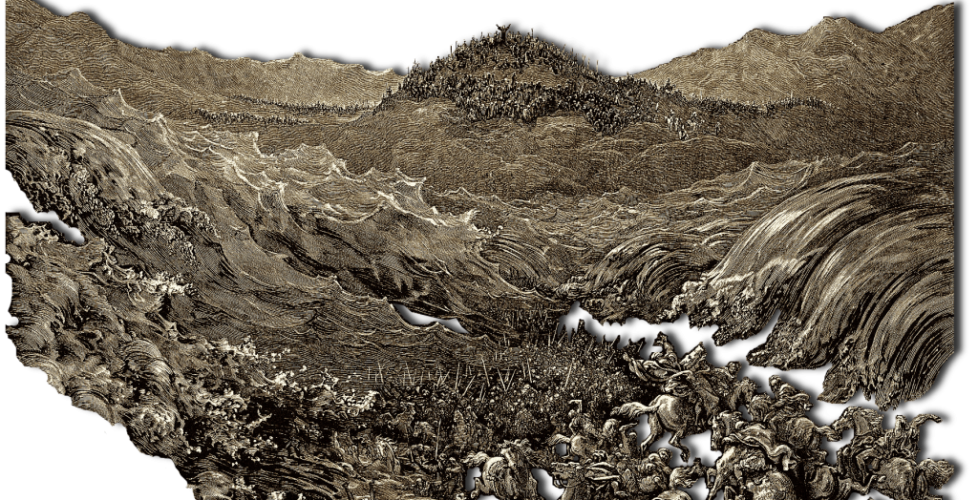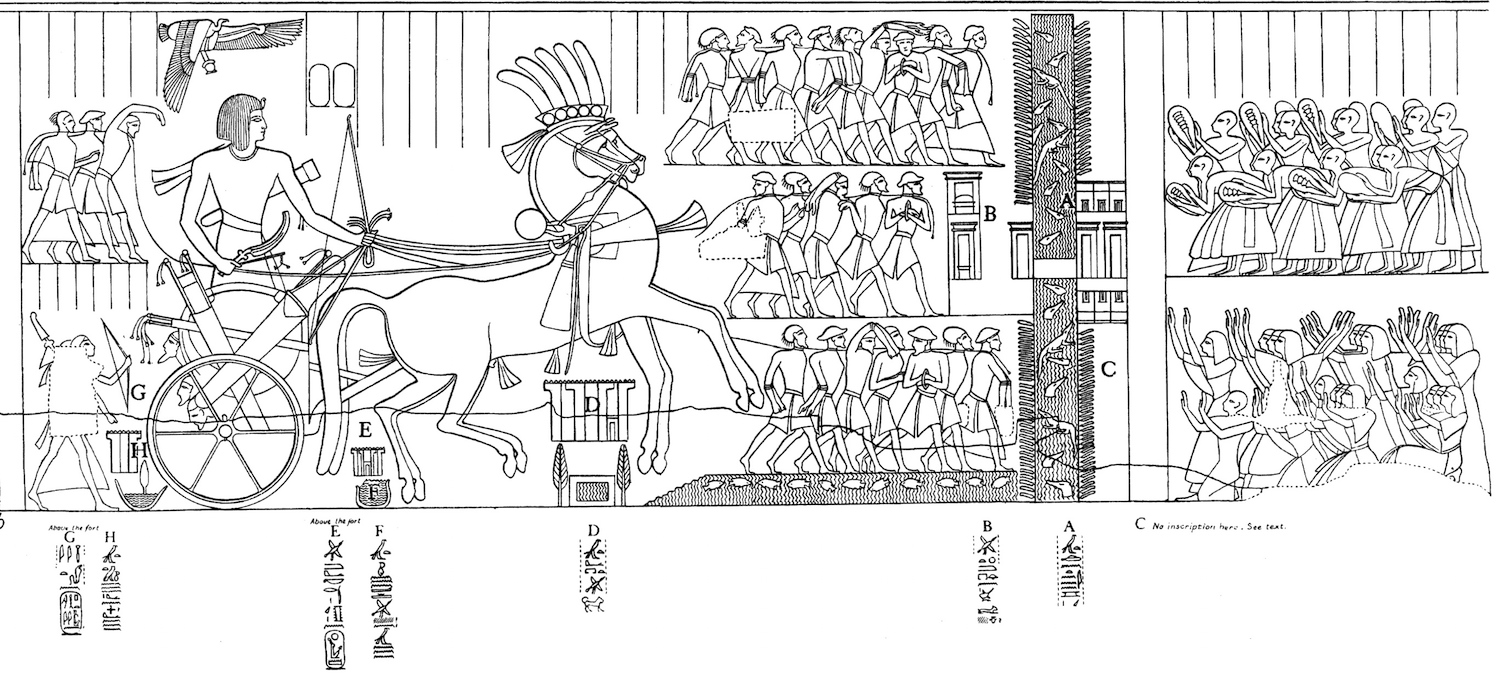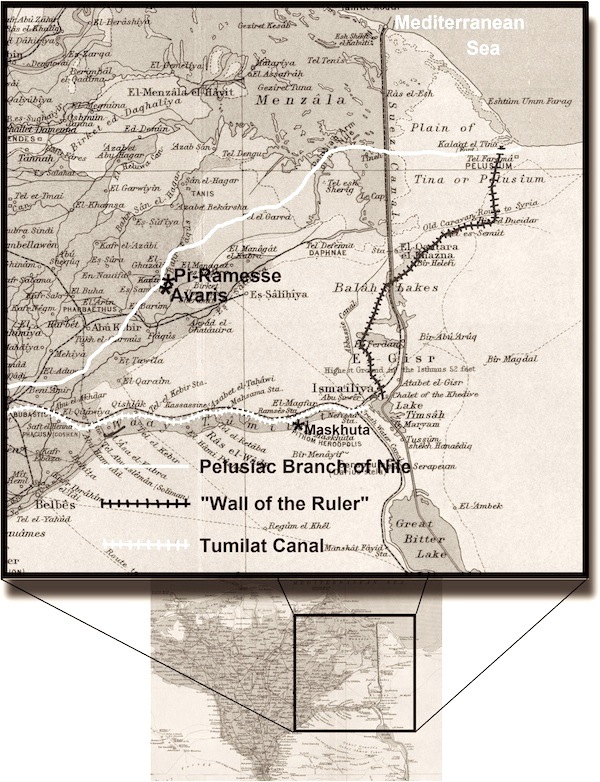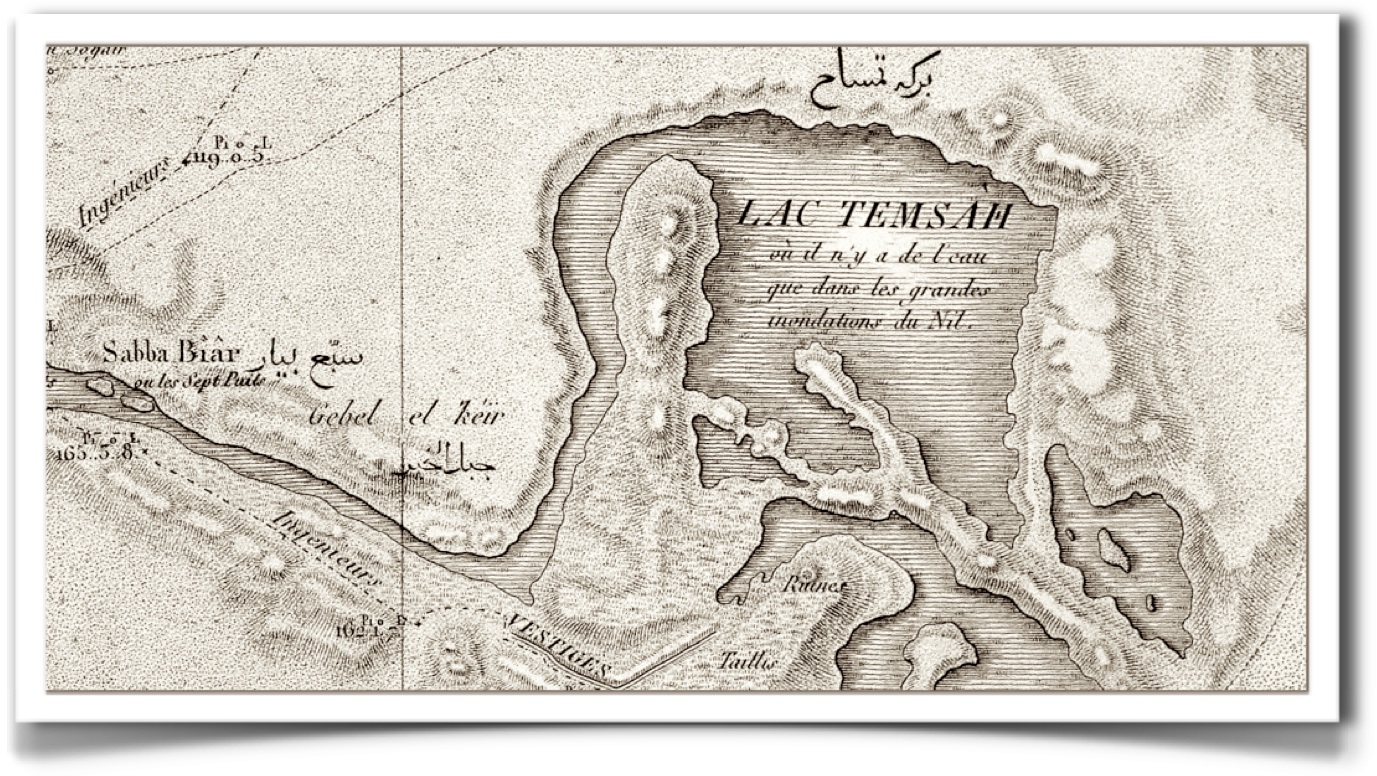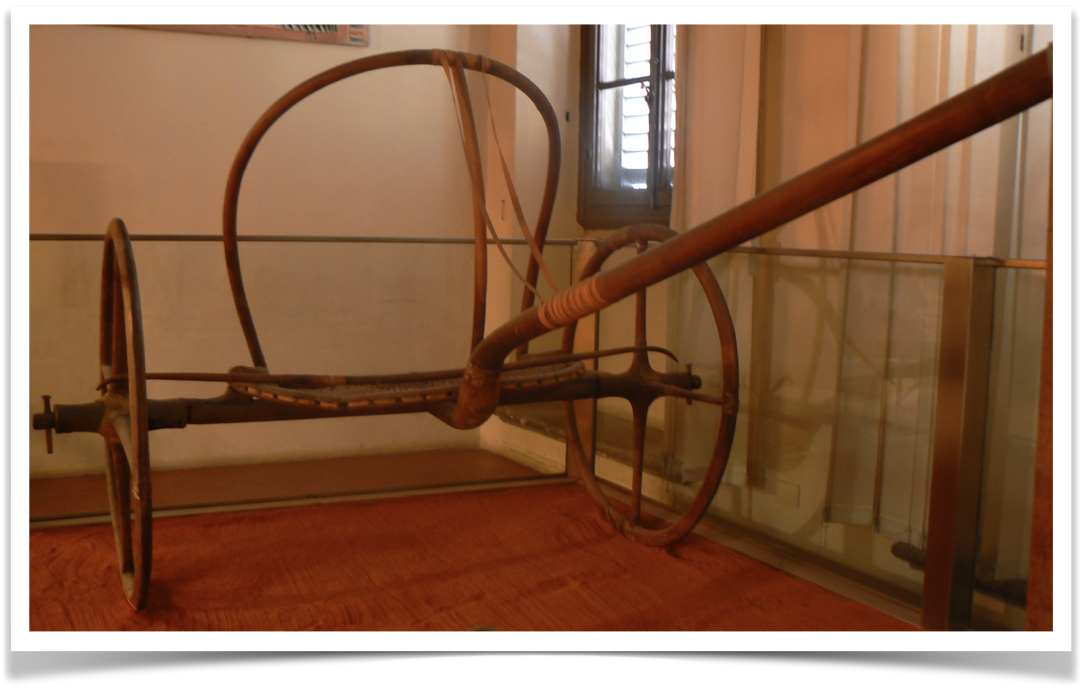The Egyptian Border Wall and the Exodus
Among other things, the following explains for the first time the extraordinary advantage of the unique timing that was prescribed for the first Passover and the Exodus, which continues to affect the calculation of the dates of Passover and Easter to this day.
One of humanity’s greatest but least known engineering feats was an ancient canal that crossed the Egyptian desert from the Red Sea to the Mediterranean, roughly the same trajectory as the modern Suez Canal. Its waterway was 230 feet wide!1 To either side, the fill from its excavation was heaped into defensive ramparts running its entire length. This created a double border wall with a massive central moat, which contemporary art shows stocked with crocodiles and a papyrus describes as heavily patrolled by watchmen.2 William H. Shea demonstrated that this was what the Egyptians had called the “Wall of the Ruler,” a combination navigational canal and border wall first proposed as a barrier against Canaanite invasion and immigration circa 2100 bc by Pharaoh Akhtoy III and finally completed by Amenemhet I circa 1960 bc.3
700 years after the Wall of the Ruler’s completion, a relief at Karnak shows Seti I returning victoriously to Egypt over this border canal via a bridge within a fort (see Fig. 1). This great wall would then almost certainly have been in use during the reign of his son Ramses II, who is widely thought to have been the pharaoh of the Exodus.
This great fortified canal/wall guarded the eastern boarder; a second canal/wall, the Tumilat Canal, lay to the south; and the Pelusiac branch of the Nile blocked the way to the west and north (see Fig. 2). With families in tow, no boats, and massive barriers on all sides, the Israelites escaping from the city of Pi-Ramesse would have been completely boxed in and doomed to be cut down or re-enslaved. In Exodus 14:3, Pharaoh concludes: “They are entangled in the land, the wilderness hath shut them in.”
Moses was told by God to avoid the northern route directly to Canaan (the heavily fortified road traveled by Seti I in the relief) but instead head southeast “toward the Red Sea” (Exodus 13:17-18). They traveled until they hit “the edge” or “border” “of the wilderness” (Exodus 13:20) at a site generally thought to be in the Wadi Tumilat. Upon hitting this border they changed course, turning again toward the Red Sea. The “border” that they hit in this area would have been the Tumilat Canal, which explains why they were forced to turn.
They were next told to camp before the sea at Pi-hahiroth, which Strong’s Exhaustive Concordance translates as “mouth of the gorges.” The word that is translated “gorges” here actually comes from a root meaning “to bore” (in the sense of making a hole) and was normally used for manmade excavations. So they camped before the sea at the “mouth of the (manmade) gorges.”
Figure 1. Seti I returns across the Egyptian border from a military campaign in Canaan with captives (and trophy heads). Awating him across the 230-foot wide border canal known as the “Wall of the Ruler,” the Egyptians cheer his victorious return. The labelled place markers filling the background make this one of the world’s oldest maps.
This a fitting description of the local geography at the time. For the mouth of the Tumilat Canal and that of the Wall of the Ruler both opened into what is now Lake Timsah, “Crocodile Lake.” And there is good reason to believe that this was part of the Red Sea at the time. The ancient geographers asserted that the Red Sea reached as far as Heroopolis, which puts it at Timsah.4 The brilliant engineer Linant de Bellefonds explored the topography of the Isthmus of Suez and studied its ancient canals extensively, before modern machinery, farming, roads, and urban expansion had a chance to bury or destroy them. He was the first to discover the remains of the Wall of the Ruler and become so inspired by it that he championed, engineered, and oversaw the construction of a modern remake, the Suez Canal. From his surveys of the geology of the isthmus, he reached the same conclusion as the records of ancient geographers, that the Red Sea had reached Lake Timsah.5 (Linant also single-handedly saved Egypt’s Great Pyramids from the fate of many other monuments. For Muhammed Ali Pasha, the Ottoman viceroy over Egypt, ordered him to dismantle the Great Pyramids and use their pre-quarried stone blocks to build the Suez Canal. Linant only spared them by convincing the Pasha that quarrying fresh stone could be done less expensively.) This explains why the original Wall of the Ruler only ran as far south as Timsah. Not until Darius circa 500 bc did the accumulation of silt and sand necessitate a southern extension of the canals from Timsah to the receding banks of the Red Sea.
On reaching the Red Sea, the Israelites could go no further and protested being led to die in this desert trap. But the Bible says that overnight the waters of the Red Sea receded, and they were able to walk across on dry land.
The Egyptians pursued in war chariots, but as they traversed the exposed sea bed in the night, their wheels sunk, stuck, and even broke off. Egyptian war chariots each carried a driver and an archer on only two narrow wooden wheels. This minimal surface area in contact with the ground was ideal for reducing friction and increasing speed in dry conditions but would have been extremely ill suited to the crossing of a wet newly exposed seafloor.
PARTING THE RED SEA
The popular image of the sea rising into great cliffs on either side of Charlton Heston is based on Exodus 14:22, “and the Israelites went through the sea on the dry ground, with a wall of water on their right and on their left.” The novel behavior of this water has been variously attributed to an earthquake, a tsunami, hurricane-force winds, an extraordinary displacement of tectonic plates (as in James Cameron’s documentary on the subject), and even as the warm, saline waters of the Red Sea somehow suddenly freezing into vertical walls of ice. At the other extreme of the passionately polarized world of Biblical scholarship, skeptics dismiss the entire narrative as an ahistorical myth.
But this is where understanding the geography and terminology of the day revolutionizes the story. At that time, the “wall of water” on the one side was the 230-foot wide, crocodile filled, rampart-lined canal, known as the “Wall of the Ruler,” which left them trapped and feeling that the situation was hopeless. On the other side was the second border “wall” that we now call the Tumilat Canal. (As in Egyptian, such aquatic boundaries could also be called “walls” in Biblical Hebrew, e.g., Nahum 3:8.) At the tip of the Red Sea, at the “mouths of the (manmade) gorges,” the Israelites passed through the sweet spot between the two walls of water, the only weak link in hundreds of miles of water walls, ramparts, and guards. Here on the active seashore, tides and waves came in and eroded the ramparts, then receded lowering their natural barrier (helped that night by a divine wind). Here the Israelites slipped the trap “with a wall of water on their right and on their left.”
NAPOLEON’S RHYME
As Twain put it, “History doesn’t repeat itself, but sometimes it rhymes.” When Napoleon Bonaparte passed through the Suez during his conquest of Egypt, he inadvertently reenacted this event, though farther south at the current tip of the Red Sea. Setting out from Suez for a day trip to the “Wells of Moses” (where the Israelites were said to have drunk following the Exodus) his expeditionary party easily crossed the Red Sea “on dry land” at low tide.
Figure 2. The eastern Nile Delta showing canals that linked the seas three thousand years before the the modern Suez Canal (the straight north-south line one third in from the right). Lined with defensive ramparts, they also served as border walls, trapping the Israelites in their flight from Pi-Ramesse during the Exodus.
Figure 3. The topography of Lake Timsah before the construction of the modern Suez Canal indicates the presence at low water levels of a broad path nearly spanning the width of the lake. At higher water levels, as in the previous map, this was covered, and it has remained so since the opening of the Suez Canal in 1869.
But on their return, the sun had set and the tide came in, briefly forcing their horses to swim as the French clung to their necks. Fortunately, they were not encumbered with chariots. The eye-witness Bourienne quoted Napoleon, “I nearly perished in the same manner as Pharaoh did. This would certainly have furnished all the Christian preachers with a magnificent test against me.”6
Circa 1800 bc, Sinuhe, fearing for his life following the mysterious murder of the pharaoh he served, fled Egypt by an escape route strikingly similar to that of the Israelites. After running into the Wall of the Ruler and hiding in a bush all day from the guards, he traveled by night to a body of salt water where he escaped to the east and made his way to Canaan. Naville identified the location of that body of water as what is now Lake Timsah.7
A later papyrus (Anastasi V) documents the flight of two slaves who escaped from Pi-Ramesse during the reign of Seti II (the successor of Merenptah) and made their way in a single day to Pithom and then out of the country to the east. This route, too, is nearly identical to that of the Israelites and suggests a crossing at or near Timsah some 600 years later, circa 1200 bc.8 This tip of the Red Sea seems to have been the chief vulnerability in Egypt’s heavily fortified eastern border.
(I have been asked to address the theory that Yam Suph, the Biblical word traditionally translated “Red Sea,” actually referred to some other body of water. I Kings 9:26 makes clear that Yam Suph was the Hebrew name for the body of water that we call the “Red Sea.” However, I have appended a fuller discussion as an endnote.9)
WHY IS THIS NIGHT DIFFERENT . . . ?
The date and time for the first Passover were said to have been dictated to Moses by God Himself. It was to begin at dusk on the 14th day of a month that began on the day of the first new moon after the barley ripened. So important was this month, that God commanded that it be the start of all future years (Exodus 12:2). For centuries afterward, Rabbis observed the barley and began the new year (and this month of Nisan) on the first new moon after it ripened. Depending on when this occurred, years could have 12 or 13 months. But why was this distinctive timing so crucial?
Prior to the construction of the two Aswan Dams, the Nile followed an annual cycle, rising from June through early October. It then returned to its banks, leaving behind the rich, damp soil in which the Egyptians planted their crops. As the crops grew, the Nile fell lower and lower until May.
In terms of this annual cycle, the timing of the first Passover falls near the Nile’s lowest level of the year. (The ripening grain signaled the end of the growing season, after which the Nile would rise and flood again.) Since the Tumilat Canal was fed from the Nile, its output into the northern tip of the Red Sea would have been drastically reduced at this time. So they departed for the Red Sea when water levels were at their lowest point of the year.
FULL MOON SYZYGY
Moses was then directed by God to begin Passover at dusk on the 14th day of this crucial month. And the Exodus was to launch urgently the following morning, the 15th day of the month. Since the month had begun on the new moon, its full moon would fall on the 14th or 15th day. The Exodus was thus to occur on (or within one day of) the full moon. Why?
Low tides reach their lowest extent twice a month on the new and full moons when the gravitational pull of the Earth, Sun, and Moon are all aligned (known as syzygy). Of these two times, full moon would clearly be the most advantageous in terms of visibility for a hazardous nocturnal escape across a temporarily exposed sea bed.
It was precisely on the unique intersection of the lowest points of the annual and monthly hydrological cycles, at the very lowest water level of the year, that the crossing of the Red Sea took place.
Not only are low tides at their lowest on the full moon, but the high tide is at its highest, and tidal currents are at their strongest. Thus, when the tide came back in, it did so with a vengeance. A battalion of charioteers strapped into heavy armor and physically exhausted (from the day’s pursuit across the desert followed by the struggle to free mired and broken vehicles) would have had great difficulty swimming and, as working-class desert-dwellers, were unlikely to know how.
Figure 4. 18th Dynasty Egyptian chariot in the Museo Archeologico, Florence, Italy. Courtesy of Philip Rickerby.
Although this event took place more than 4,000 years ago, it remains relevant today, still celebrated by millions of descendants of that ancient Exodus every year on the 14th day of the month Nisan, on the night of the full moon. Easter was originally celebrated on the same day (the Lord’s Supper having been a Passover Seder and the crucifixion having coincided with the Exodus) and is still called “Passover” in most European languages. Its timing was deliberately divorced from the Jewish calendar in 325 ad by the Council of Nicaea, but Easter still pivots on that same full moon, now falling on the first Sunday after the first full moon after the vernal equinox.
NOTES
1. A. Sneh, T. Weissbrod, and I Perath, “Evidence for an Ancient Egyptian Frontier Canal,” American Scientist 63 (1975): 542-48.↩
2. Ibid., 37.↩
3. William H. Shea, “A Date for the Recently Discovered Eastern Canal of Egypt,” Bulletin of the American Schools of Oriental Research, No. 226 (April, 1977): 35.↩
4. The Classical geographers describe the Red Sea as reaching as far north as Heroopolis (Pi-Atum or Pithom), indicating that it reached Lake Timsah (cf. Pliny Natural History 6.165, Strabo 16.769, Agathemeros). They even referred to the Gulf of Suez as the Heroopolitan Gulf. This would explain why the early canals terminated at this lake. And it explains why Darius found it necessary to add a new leg to the ancient canal system circa 500 bc, to rejoin Lake Timsah to the receding coast of the Red Sea. ↩
5. Linant de Bellefonds, Mémoires sur les principaux travaux d’utilité publique exécutés en Egypte depuis les temps de la plus haute antiquité jusqu’à nos jours (Paris: Librairie Scientifique et Maritime, 1872-1873), 195-97.↩
6. Louis Antoine Fauvelet de Bourrienne, The Memoirs of Napoleon, 1799, Volume 3; (Kessinger Publishing, 2004), 20.↩
7. Edouard Naville, The store-city of Pithom and the Route of the Exodus (London: The Offices of the Egypt Exploration Fund, 1903), 26.↩
8. Papyrus Anastasi V, 19:2-20:6; Kenneth Anderson Kitchen, Ramesside Inscriptions, Translated and Annotated Notes and Comments (Oxford: Blackwell Publishers, 1999), 109: Sir Alan H. Gardiner, Late-Egyptian Miscellanies (Brussels, 1937), 66-7; Ricardo Augusto Caminos, Late- Egyptian Miscellanies (Oxford: Oxford University Press, 1954), 254.↩
9. The word yam comes from a root meaning “to roar” and was used 278 times in the Bible to refer to the sea, most frequently the Mediterranean. Linguistically, Hebrew is classified as a Canaanite language, and within the other languages of that group it is also clear that Yam was the word for “sea,” and was even personified as Yam, the great god of the sea. It does not refer to a shallow marsh or inland lake as has been proposed. Suph may mean “reeds,” “seaweed” (as in Jonah 2:5), or “end” (Strong’s 5486). The latter meaning of “End Sea” parallels an Egyptian and Greek term for the Red Sea (Maurice Copisarow, “The Ancient Egyptian, Greek and Hebrew Concept of the Red Sea,” Vetus Testamentum XII (1962), 3.) Moreover, I Kings 9:26 explicitly confirms that Yam Suph is the Hebrew term for the body of water that we call the “Red Sea.” And, in translating the Bible from Hebrew into Greek in the 3rd century BC, 70 of the best Greek and Hebrew scholars of the ancient world recognized Yam Suph as the Hebrew term for this body of water and consistently translated it as such.↩
